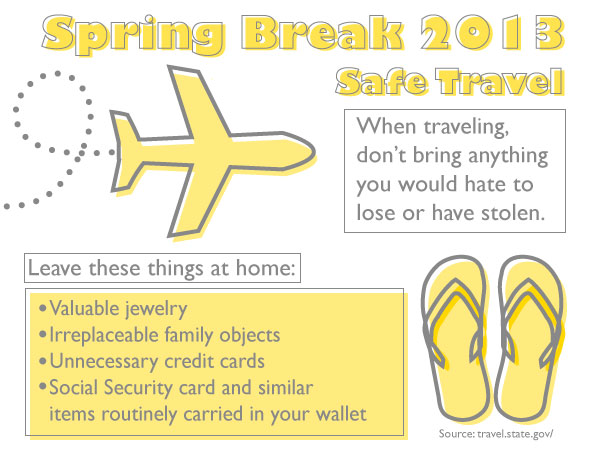
Your bags are packed for spring break, midterms are finished and dreams consist of days in the sun and nights on the beach. The only thing you’re probably not thinking about when you consider your spring break vacation is how you’re going to get there.
Statistics released by the National Safety Council show the odds of dying in a plane crash in your lifetime are one in 7,178. The odds of dying in a motor vehicle accident are one in 98 over the course of a lifetime.
Senior Mike Skelton said he’s driving to Texas for his spring break despite the staggering statistics.
“I’ve usually done air travel growing up,” Skelton said. “I don’t mind road trips.”
Skelton is not alone. According to a U.S. Travel Association study, 76 percent of those surveyed reported traveling by car to their spring break vacation spot, while 42 percent reported traveling by air.
Associate Director of Study Abroad Tim Dohmen offered advice to those choosing the road versus the air.
“All of us have probably heard that statistically flying is far safer than driving,” Associate Director of Study Abroad Tim Dohmen said. “If you are planning to take a long-distance road trip with friends, I think the most important thing is to get appropriate sleep. Pulling a 24-hour, Red Bull-fueled shift behind the wheel is definitely dangerous.”
While driving seems like the cheaper, more pragmatic option, studies show that air travel is much safer.
“I’ve flown for most of my vacations growing up,” freshman Maddie Mingo said. “I’m flying to Hawaii for spring break. (Air travel) doesn’t bother me.”
However, choosing to fly does offer unique problems of its own. The hassle of the airport can compound the complications of travel, leading to a stressful and sometimes unsafe trip.
Dohmen said students often experience issues with the time it takes to go through pre-flight screening and security.
“In most cases, if one gets to the airport a couple of hours ahead of time there shouldn’t be a problem checking your luggage and getting through security in a timely manner,” Dohmen said.
Extra measures must be taken by those who travel out of the country for spring break, Dohmen said.
A trip to Mexico is the common choice for those who choose to spend their break abroad. The Bureau of Consular Affairs reported that more than 100,000 young adults choose to travel to Mexico for spring break every year.
Dohmen stressed that travelers get to know their destination before leaving and make sure to have the appropriate immigration documents for where they are going.
“Once in the country, students should be aware of the laws of the country and that being an American doesn’t necessarily give them the same rights that they might have at home,” Dohmen said. “It never hurts to do a little bit of research on culture of the country you are visiting so that you have a better sense of the values of norms.”
Some students who have traveled in the past have noticed a difference between traveling abroad and traveling domestically.
“Florida was more comfortable,” Mingo said when comparing past spring break trips to Florida and Mexico.
The Bureau of Consular Affairs emphasized not taking expensive or irreplaceable items on your vacation to look less affluent, making you less of a target for thieves when traveling. Don’t take anything you wouldn’t want to lose or any unnecessary credit cards.
Travelers are also advised to pack as light as possible. Bringing unnecessary items makes bags heavier and more difficult to carry, making you less likely to carry them at all times and more likely to leave your luggage unattended.
Above all, Dohmen stressed an awareness surroundings as the key to staying safe over spring break.
“Remember that your safety is never guaranteed,” Dohmen said. “You should research or try to find out what some of the potential dangers might be where you are planning to travel.”
Jacob Sevening can be reached at seve8586@stthomas.edu.

